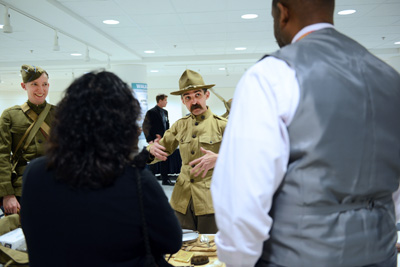Army marks centennial of U.S. entering World War I
By C. Todd Lopez
WASHINGTON (April 06, 2017) -- One hundred years ago today the United States formally declared war against Germany and entered the bloody conflict that had already consumed the European continent for more than two years.
By the end of World War I on Nov. 11, 1918, more than 38 million were dead. About 117,000 of them were American Soldiers.

During a WWI commemoration ceremony Thursday at the Pentagon Chief of Staff of the Army Gen. Mark A. Milley outlined the events that quickly followed the June 28, 1914, assassination of Archduke Franz Ferdinand of Austria and drew the nations of Europe into war.
And he asked his audience whether the leaders of today have the vision to prevent such a conflict from happening again.
"Are we better at decision-making today?" Milley asked his audience. "Are there similarities in the structure or rising powers? Are there similarities and interconnectedness where nobody can fathom or imagine or believe conflicts of this size and scope and levels of violence could ever happen?"
In response to the assassination, Ferdinand's uncle -- the Emperor of Austria, Franz Joseph -- mobilized the Austrian army against the Serbians. The Russians, in turn, mobilized their army to support the Serbians.
The Germans, Milley said, couldn't allow the Russians to "pick on their Germanic brothers in Austria," so Kaiser Wilhelm II mobilized the German army against the Russians. And because France and Russia were treaty allies, France mobilized its army as well.
And the British, Milley noted, "were allied with France, and they mobilized as well."
No one believed the conflict would last long, Milley explained. But the series of mobilizations and the initiation of Germany's Von Schlieffen Plan and France's Plan 17 launched Europe into a conflict that was unprecedented in world history in the scale of its slaughter and destruction.
"There was absolutely no logical reason, most thought, to have a war," Milley said. "Yet each of the decision makers in those respective countries mobilized and launched their nations into an incredible cataclysm of war."
On the 100th anniversary of the United States entry into WWI, Milley said, we owe it those who donned uniforms 100 years ago to go overseas and fight to reflect on the causes and nature of the war that took so many lives.
"We owe it to the 99 divisions that were mobilized in World War I," Milley said. "Even though none of them are alive today, we owe it to all of them to clearly and unambiguously understand what World War I was about, how it started, and vow -- vow upon their graves -- that we never let it happen again."